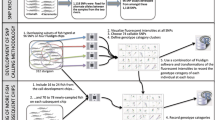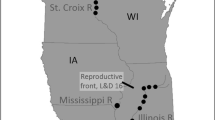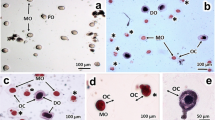Abstract
Invasions by Asian carps have become a high profile topic due to the threat they pose to native ecosystems and associated economies. One of four primary invasive Asian carp species, Grass Carp, Ctenopharyngodon idella (Cyprinidae), is commonly produced as triploid, sterile, individuals and stocked as a biological control for the suppression of unwanted aquatic vegetation. Illegal sale and transport of diploid fish can result in unwanted fertile populations. Current methods of determining ploidy of an individual require the use of laboratory equipment (Coulter Counter) and are not possible to perform under field conditions. Here we introduce a rapid, inexpensive technique to distinguish diploid fertile versus triploid sterile Grass Carp under field conditions using a compound microscope. We compared blood smears of known diploid and triploid Grass Carp individuals, finding that the frequency of abnormally shaped erythrocyte nuclei (dumbbell or teardrop shaped) is significantly higher in the latter. This difference is accompanied by larger cell and increased nuclear volumes, and it is significantly correlated with Coulter Counter values (the standard measure of ploidy used by the United States Fish and Wildlife Service). Additionally, we field tested our method on a managed, presumably triploid, standing stock of Grass Carp and found that all individuals tested exhibited proportions of abnormal nuclei typical of triploids. Finally, a blinded study was used to confirm diagnostic reliability of our visual assessment of ploidy. Examination of blood smears for abnormally shaped nuclei may become a powerful tool in the management of invasive Grass Carp.





Similar content being viewed by others
References
Allen SK, Stanley JG (1983) Ploidy of hybrid grass carp × bighead carp determined by flow cytometry. Trans Am Fish Soc 112:431–435. doi:10.1577/1548-8659
Allen SK, Wattendorf RJ (1987) Triploid Grass Carp: status and management implications. Fisheries 12:20–24. doi:10.1577/1548-8446
Bain MB (1993) Assessing impacts of introduced aquatic species: grass carp in large systems. Environ Manag 17:211–224. doi:10.1007/BF02394691
Beck ML, Biggers CJ (1983) Erythrocyte measurements of diploid and triploid Ctenopharyngodon idella × Hypophthalmichthys-nobilis hybrids. J Fish Biol 22:497–502. doi:10.1111/j.1095-8649
Beck ML, Biggers CJ, Dupree HK (1980) Karyological analysis of Ctenopharyngodon idella, Aristichthys nobilis and their FI hybrid. Trans Am Fish Soc 109:433–438
Benjamini Y, Hochberg Y (1995) Controlling the false discovery rate: a practical and powerful approach to multiple testing. J R Stat Soc B 57:289–300
Bonar SA, Thomas GL, Pauley GB (1988) Evaluation of the separation of triploid and diploid grass carp, Ctenopharyngodon idella (Valenciennes), by external morphology. J Fish Biol 33:895–898. doi:10.1111/j.1095-8649
Cassani JR (1996) Managing aquatic vegetation with grass carp: a guide for water resource managers. American Fisheries Society, Bethesda, pp 196
Cassani JR, Caton WE (1985) Induced triploidy in grass carp, Ctenopharyngodon idella Val. Aquaculture 46:37–44. doi:10.1016/0044-8486
Chapman DC, Davis JJ, Kocovsky PM, Miner JG, Farver J, Jackson PR (2013) First evidence of grass carp recruitment in the Great Lakes Basin. J Gt Lakes Res 39:547–554. doi:10.1016/j.jglr.2013.09.019
Coulter WH (1953) Means for counting particles suspended in a fluid. US Patent 2,656,508. 20
Cuddington K, Currie WJS, Koops MA (2014) Could an Asian carp population establish in the Great Lakes from a small introduction? Biol Invasions 16:903–917. doi:10.1007/s10530-013-0547-3
Garcia LS (2001) Diagnostic medical parasitology, 4th edn. ASM Press, Washington
Guillory V, Gassaway RD (1978) Zoogeography of the grass carp in the United States. Trans Am Fish Soc 107:105–112. doi:10.1577/1548-8659
Hargrave CW, Gido KB (2004) Evidence of reproduction by exotic grass carp in the Red and Washita Rivers, Oklahoma. Southwest Nat 49(1):89–93. doi:10.1894/0038-4909(2004)049
Khmelinskii A, Ventura R, Sanches J (2010) A novel metric for bone marrow cells chromosome pairing. IEEE Trans Biomed Eng 57:1420–1429. doi:10.1109/tbme.2010.2040279
Kocovsky PM, Chapman DC, McKenna JE (2012) Thermal and hydrologic suitability of Lake Erie and its major tributaries for spawning of Asian carp. J Gt Lakes Res 38:159–166. doi:10.1016/j.jglr.2011.11.015
Kolar CS, Chapman DC, Courtenay WR Jr, Jennings DP (2005) Asian carps of the genus Hypophthalmichthys (Pisces, Cyprinidae)—biological synopsis and environmental risk assessment: a report to US Fish and Wildlife Service per Interagency Agreement 94400-3-0128. US Geological Survey, La Crosse
Lu WT, Liu SJ, Long Y, Tao M, Zhang C, Wang J, Xiao J, Chen S, Liu JH, Liu Y (2009) Comparative study of erythrocytes of polyploidy hybrids from various fish subfamily crossings. Cell Tissue Res 336:159–163. doi:10.1007/s00441-009-0759-0
Magee SM, Phillipp DP (1982) Biochemical genetic analyses of the grass carp ♀ × bighead carp ♂ F1 hybrid and the parental species. Trans Am Fish Soc 111:593–602
Marian T, Krasznai Z (1978) Kariological investigation of Ctenopharyngodon idella and Hypophthalmichthys nobilis and their cross-breeding. Aquac Hung 1:44–50
McCarter NH (1988) Verification of the production of triploid grass carp (Ctenopharyngodon idella) with hydrostatic pressure. N Z J Mar Freshw Res 22:501–505. doi:10.1080/00288330
Purdon CE (1983) Genetic engineering by manipulation of chromosomes. Aquaculture 33:287–300. doi:10.1016/0044-8486
Richardson MJ, Whoriskey FG, Roy LH (1995) Turbidity generation and biological impacts of an exotic fish Carassius auratus, introduced into shallow seasonally anoxic ponds. J Fish Biol 47:579–585. doi:10.1006/jfbi.1995.0161
Sampson SJ, Chick JH, Pegg MA (2009) Diet overlap among two Asian carp and three native fishes in backwater lakes on the Illinois and Mississippi rivers. Biol Invasions 11:483–496. doi:10.1007/s10530-008-9265-7
Schofield PJ, Williams JD, Nico LG, Fuller P, Thomas MR (2005) Foreign nonindigenous carps and minnows (Cyprinidae) in the United States—a guide to their identification, distribution, and biology: scientific investigations report 2005-5041. US Geological Survey, Reston
Sezaki K, Kobayasi H, Nakamura M (1977) Size of erythrocytes in the diploid and triploid specimens of Carassius auratus langsdorfi. Jpn J Ichthyol 24:135–140
USFWS (2013) National Triploid Grass Carp Inspection and Certification Program. United States Fish and Wildlife Service. http://www.fws.gov/warmsprings/fishhealth/frgrscrp.html. Accessed 17 October 2013
Wattendorf RJ (1986) Rapid identification of triploid grass carp with a Coulter counter and channelyzer. Progress Fish-Cultur 48:125–132. doi:10.1577/1548-8640
Zar JH (1999) Biostatistical analysis, 4th edn. Prentice Hall International, London
Acknowledgments
M. Freeze and Keo Fish Farms provided blood samples and Coulter Counter values. K. Edelen, S. Koth, T. Krynak, T. Robison, S. Searles, N. Zarlinga, Cleveland Metroparks, and Cleveland Metroparks Zoo provided logistical support and granted permission to sample the zoo fish. We thank T. Robison and the staff/interns of Cleveland Metroparks’ Watershed Stewardship Center for their participation in the blinded survey. Assistance with microscopy and imaging was provided by Scott Howell and the Visual Sciences Research Center Microscopy & Digital Imaging Core grant P30-EY11373. Funding was provided by Case Western Reserve University and Cleveland Metroparks.
Author information
Authors and Affiliations
Corresponding author
Rights and permissions
About this article
Cite this article
Krynak, K.L., Oldfield, R.G., Dennis, P.M. et al. A novel field technique to assess ploidy in introduced Grass Carp (Ctenopharyngodon idella, Cyprinidae). Biol Invasions 17, 1931–1939 (2015). https://doi.org/10.1007/s10530-015-0856-9
Received:
Accepted:
Published:
Issue Date:
DOI: https://doi.org/10.1007/s10530-015-0856-9




